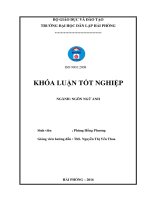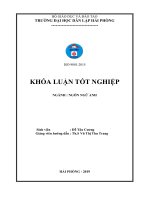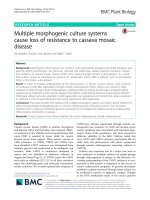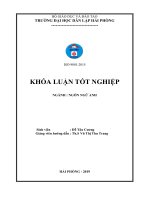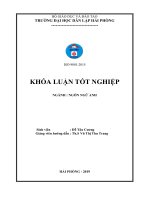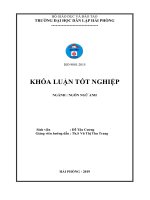Investigation of resistance to leaf mold disease on tomoto by dna marker (khóa luận tốt nghiệp)
Bạn đang xem bản rút gọn của tài liệu. Xem và tải ngay bản đầy đủ của tài liệu tại đây (4.94 MB, 75 trang )
VIETNAM NATIONAL UNIVERSITY OF AGRICULTURE
FALCUTY OF BIOTECHNOLOGY
------- -------
GRADUATION THESIS
TOPIC:
“INVESTIGATION OF RESISTANCE TO LEAF MOLD
DISEASE ON TOMATO BY DNA MARKER”
Ha Noi- 2022
VIETNAM NATIONAL UNIVERSITY OF AGRICULTURE
FALCUTY OF BIOTECHNOLOGY
------- -------
GRADUATION THESIS
TOPIC:
“INVESTIGATION OF RESISTANCE TO LEAF MOLD
DISEASE ON TOMATO BY DNA MARKER”
Student
: Pham Quy Tung
Student’s code
: 637087
Class
: K63CNSHE
Major
: Biotechnology
Supervisor
: Pham Thi Dung, Ph.D
Ha Noi- 2022
GUARANTEE
I hereby declare that this thesis is completely done by my own scientific
research under the guidance of Mrs. Pham Thi Dung Ph.D, Faculty of
Biotechnology - Vietnam Academy of Agriculture. All figures in this thesis are
truthful, and do not duplicate the results of any previous graduate report.
Graduation thesis has references to documents, citation information is recorded
in the references section.
I take responsibility for my promises to the board and the university.
Hanoi, December 2022
Student
Pham Quy Tung
i
Acknowledgements
First words, in the process of completing this research paper, I have
received great deal of helps, guidance and encouragements from teachers and
friends.
First of all, I would like to express my deepest thanks to my supervisor,
Mrs. Pham Thi Dung who given me suggestions on how to shape the study and
always been most willing and ready to give my valuable advice, helpful
comments as well as correction of my reseach paper.
Next, I would like to express my gratitude to all teachers in Biotechnology
falcuty- Vietnam university of Agriculture for their lectures 5 years that help me
much in completing this paper. Besides that, I’m so thankful for all the support and
encouragement of Mr. Phan Huu Ton and your employees at the Center for
Conservation and Development of Plant Genetic Resources who helped and created
the most favorable conditions for me during my internship.
Last but not least, I would like to thank my family and my friends who
have always encouraged, supported and helped me to complete this paper
Ha Noi, December 2022
Student
Pham Quy Tung
ii
TABLE OF CONTENTS
GUARANTEE ....................................................................................................... i
Acknowledgements ............................................................................................... ii
TABLE OF CONTENTS ..................................................................................... iii
LIST OF TABLES ................................................................................................ v
LIST OF FIGURES .............................................................................................. vi
ABBREVIATIONS ............................................................................................. vii
ABSTRACT ....................................................................................................... viii
CHAPTER I: INTRODUCTION ...................................................................... 1
1.1. Rationale........................................................................................................ 1
1.2. Aim and requirements of the study ............................................................... 2
1.2.1. Aim ............................................................................................................ 2
1.2.2. Requirements ............................................................................................... 2
CHAPTER II: LITERATURE REVIEW......................................................... 3
2.1. Introduce about tomato .................................................................................. 3
2.1.1. The origin .................................................................................................... 3
2.1.2. Nutritional value .......................................................................................... 3
2.1.3. Characteristics of tomato plants .................................................................. 4
2.1.4. Tomato ripeness .......................................................................................... 6
2.1.5. Popular varieties of tomatoes ...................................................................... 7
2.2. The situation of tomato production in the world and in the country ............. 9
2.2.1. The situation of tomato production in the world ........................................ 9
2.2.2. The situation of tomato production in Vietnam ........................................ 10
2.3. Leaf mold disease on tomato plants ............................................................. 11
2.3.1. Symptoms and signs of disease ................................................................. 12
2.3.2. Causes of leaf mold disease ...................................................................... 12
2.3.3. Developmental features of the disease ...................................................... 13
2.3.4. Measures to prevent leaf mold disease ..................................................... 14
2.4. Status of research on resistance to leaf mold disease in tomatoes ............... 15
iii
2.4.1. Studies on resistance to leaf mold in the world ........................................ 15
CHAPTER III. RESEARCH MATERIALS AND METHODS ................... 20
3.1. Research Materials ....................................................................................... 20
3.1.1. Research subjects ...................................................................................... 20
3.1.2. Place and time of study ............................................................................. 21
3.2. Research content .......................................................................................... 21
3.3. Research Methods ........................................................................................ 22
3.3.1. Experimental layout .................................................................................. 22
3.3.2. Methods for assessing important agronomic traits ................................... 22
3.3.3. Evaluation of resistance to leaf mold disease of selected tomato
varieties by using molecular markers.......................................................... 25
CHAPTER IV: RESULTS AND DISCUSSION ............................................ 28
4.1. Survey on genetic diversity of researched tomato varieties........................ 28
4.1.1. Morphological survey of tomato samples studied .................................... 28
4.1.1.1 Survey on some growth characteristics, morphological characteristics
and structure of tomato ............................................................................... 28
4.1.1.2 Investigate the characteristics of inflorescence structure, bloom
characteristics, yield and yield factors. ....................................................... 31
4.1.1.3 Fruit morphology survey ......................................................................... 34
4.2. Results of PCR method to detect Cf-19 gene in the studied tomato group . 37
4.2.1. DNA total of leaf tomato........................................................................... 37
4.1.2. Determination of DNA content by nano drop ........................................... 39
4.2.3. Results of PCR products detecting Cf-19 gene ........................................ 40
4.3 Selection of a number of promising seed varieties with good characteristics .. 42
CHAPTER V. CONCLUSIONS AND RECOMMENDATIONS ................ 43
5.1 Conclusions ................................................................................................... 43
5.2 Recommendations ......................................................................................... 43
Addendum ........................................................................................................... 49
iv
LIST OF TABLES
Table 2.1 Nutrition facts in 100g tomatoes ........................................................... 3
Table 2.2 Area harvested, yield and production over the world of tomatoes ..... 10
Table 4.1 Some growth characteristics, morphological characteristics and
tree structure of the studied varieties .................................................. 30
Table 4.2 Some characteristics of inflorescence structure, bloom
characteristics, yield and yield factor ................................................. 33
Table 4.3 Survey about some characteristics of fruit morphology ..................... 35
Table 4.4 Survey about some characteristics of fruit quality.............................. 37
Table 4.5 Determination of DNA content by nano drop .................................... 39
Table 4.6 Results of PCR products detecting Cf-19 gene by primer qrt5760A ................................................................................................. 40
Table 4.7 Results of PCR products detecting Cf-19 gene by primer qrt5780A .................................................................................................. 41
Table 4.8 Results of PCR products detecting Cf-19 gene by primer qrt5760A and primer qrt-5780A.............................................................. 42
Table 4.9 Selection of promising varieties.......................................................... 42
v
LIST OF FIGURES
Figure 2.1 Structure of tomato .............................................................................. 6
Figure 2.2 Leaf mold caused by Passalora fulva on commercially and hom grown
tomatoes. The disease develops rapidly, spreading from lower to upper
leaves ..................................................................................................... 11
Figure 2.3 Leaf mold on a tomato leaflet. Yelloe diffuse spots or patches are
present on the upper leaflet surface and olive green to brown fungal
spores are found on the corresponding underside of the leaflet ........... 12
Figure 2.4 The Cf-9/Cf-4/Cf-1 (Milky Way) and Cf-2/Cf-5 Loci in Tomato .... 16
Figure 2.5 Recognition Specificity in Cf-2 and Cf-5 .......................................... 18
Figure 4.2 DNA total of leaf tomatos.................................................................. 38
Figure 4.3 Results of PCR products detecting Cf-19 gene by primer qrt5760A .................................................................................................... 40
Figure 4.4 Results of PCR products detecting Cf-types gene by primer qrt-5780A . 41
vi
ABBREVIATIONS
Avr:
Avirulence gene
C. fulvum: Cladosporium fulvum
CTAB:
Cetyl Trimethyl Ammonium Bromide
Hcr2:
homologues of Cladosporium resistance gene Cf-2
Hcr9:
homologues of Cladosporium resistance gene Cf-9
LRR:
leucine-rich repeat
R gene:
resistance gene
vii
ABSTRACT
Leaf mold disease, caused by the fungus Passalora fulva, is one of the
most devastating diseases in most tomato growing regions worldwide. To date,
many disease resistance genes have been published and the use of natural
resistance genes has been identified as one of the most effective solutions in
breeding tomato varieties resistant to leaf mold disease. This study used DNA
markers to detect Cf-19 resistance genes in 20 tomato cultivars stored at the
Center for Conservation and Development of Plant Genetic Resources - Vietnam
National University of Agriculture. To select promising tomato cultivars,
selection was based on important agro-biological characteristics such as fruit set
rate, fruit shape index, and presence of resistance genes. The result show that
there were 4 varieties suitable for breeding and producing 2and KT.
viii
*, 10-
, 2-
CHAPTER I: INTRODUCTION
1.1.
Rationale
Tomato (Lycopersicon esculentum Mill), belonging to the Solanaceae
family, native to Middle and South America, is one of the most widely grown
and consumed fruit vegetables today. Tomato is a crop with high economic
value, promoting investment and development to improve the yield and quality
of tomato products in order to increase income for farmers, contributing to
hunger eradication and poverty alleviation is one of the current agricultural
development policies of our country. However, the tomato production process in
our country is still facing many difficulties, one of the causes limiting the
production development and reducing tomato yield is leaf mold disease. Tomato
leaf mold disease has been studied for a long time, but so far the disease is still a
common pest and greatly affects the yield and quality of tomatoes.
Tomato leaf mold disease caused by the fungus Passalora fulva
(previously called Fulvia fulva or Cladosporium fulvum) is one of the most
harmful diseases in most tomato growing areas in Vietnam and around the
world. The disease can cause damage throughout the growing period of the
plant. The fungus damages many parts of the tomato plant such as stems, leaves,
flowers and fruits. Spores of the fungus can survive for 6 months to a year above
ground at room temperature. Tomato production is mainly focused on winter
and winter-spring crops, these are the most suitable time for leaf mold disease to
arise and develop, causing great losses to economy and productivity.
Currently, disease control is mainly by chemical methods. But it also
comes simultaneously with the consequences of environmental pollution,
creating resistance to diseases and affecting human and livestock health.
Therefore, finding safe and effective measures to prevent leaf mold disease on
tomatoes is one of the urgent task nowaday.
Breeding new varieties with genetic resistance to Passalora fulva is the
most effective way to minimize the damage caused by leaf mold disease.
1
Therefore, effective use of new resistance (R) genes by breeders is essential.
Over the decades, researchers have identified resistance genes for leaf mold
disease, including Cf-2, Cf-4, Cf-5, Cf-8, Cf-9, Cf-11 and Cf-19. (Lindhout et al,
1989; TingTing Zhao, 2016)
Today, in plant breeding, the method of selection of molecular markers
linked to the target genes has become an effective tool that can quickly, early
and accurately select traits regardless of into the environment (Zhao et al,2016).
Although there have been some lines of tomato resistant to leaf mold disease
have been selected, but the results are very limited and need to be further
researched.
Starting from the above basis, in order to serve the work of selecting and
creating tomato varieties carrying the gene for resistance to leaf mold disease,
we carried out the reseach: ―Investigation of resistance to leaf mold disease on
tomato by DNA marker”
1.2.
Aim and requirements of the study
1.2.1. Aim
Detecting genetic resources to identify tomato varieties with good yield
and quality, containing genes for resistance to leaf mold disease for breeding
work.
1.2.2. Requirements
Evaluation of some important agrobiological traits in tomato corporation.
Using molecular markers to identify leaf mold resistance genes in tomato
consortium
2
CHAPTER II: LITERATURE REVIEW
2.1. Introduce about tomato
2.1.1. The origin
Tomato originated in Peru, a country in South America, is vegetable of
the family "Solanaceae", scientifically known as "Lycopersicon sculentum
Mill". Tomato was popularized in China and Southeast Asian countries around
the 17th century and became one of the important vegetables in many countries.
However, Mexico was the first country to cultivate the tomato plant. (Trinh Thi
Le,2016)
2.1.2. Nutritional value
Tomatoes are succulent, watery (about 90-95%), have a different number
of cells (also known as seed chambers) (2-3 sometimes more). Fruit shape can
be flat, round, elliptical, long oval, plum shape, pear shape..., weight 30150g/fruit. (Trinh Thi Le,2016)
Tomatoes are sweet, cool, have the effect of creating energy, balancing cells
and increasing vitality. In ripe tomatoes contain many nutrients such as sugar,
vitamins A, C... phosphorus, calcium, copper, magnesium, β-catoten... and
Lycopene. Due to its rich nutritional composition, tomatoes have become a popular
dish in many countries and are widely grown food crops across the continent.
(Trinh Thi Le,2016)
Table 2.1 Nutrition facts in 100g tomatoes
Element
H2O
Carbohydrates
Protein
Total digestible fiber
Calcium
Phosphorus
Vitamin B5
Vitamin A
Vitamin C
Unit
g
g
G
Content
94.00
3.92
0.88
G
1.20
Mg
Mg
Mg
Mg
mg
10-12.00
26.00
0.09
13.00
40.00
3
Element
Vitamin B1
Vitamin B2
Vitamin PP
Zinc, copper,
magnesium
Vitamin B6
Vitamin E
Β-caroten
Lycopene
Unit
mg
Mg
Mg
Content
0.06
0.04
0.50
Mg
0.10-100
Mg
Mg
Mg/kg
Mg/kg
0.08
0.54
4.49
20-200
2.1.3. Characteristics of tomato plants
Tomato is a diploid plant with 2n=24 chromosomes, which is characterized
by the following characteristics:
Roots: The root system is clustered, deeply rooted and strongly branched,
the ability to develop secondary roots is very large. After 2 months of planting,
the roots were widely distributed in the topsoil with a thickness of 60 cm, most
concentrated in the soil layer 30 cm from the surface (Duong Hong Dat, 2003).
Under field conditions, tomato roots can be eaten up to 1.3 m wide and up to 1
m deep (Thompson et al., 1999). With such a large root mass, tomatoes are
classified as drought tolerant. The root system is shallow or deep, strong or
weak growth is related to the degree of branching and development of the
aboveground parts. Therefore, it is necessary to prune the branches, press the
appropriate tops for the favorable development of tomato roots.
Stem: The stem is round, succulent, covered with many dragons, when the
tree is large, the trunk turns to wood. The characteristic of tomato is that it spreads
around or grows into a bush. Based on the growth characteristics, tree height can
be classified into 3 types: dwarf type (under 65cm), medium type (65-120cm), tall
type (from 120-200cm). In the process of growing, tomato plants will grow a lot
of axillary buds making the tree dense, so in production it is necessary to prune
branches to concentrate nutrients on fruit.( Dinh Thi Hue, 2013)
Leaves: Tomato leaves are the morphological feature that distinguishes
one variety from another. Most tomato leaves are compound leaves, each
complete leaf consists of 3-4 pairs of leaflets. In between pairs of leaflets there
is also a middle leaf, on the base of the leaflet there are small leaves called
lateral leaves. Depending on the variety, tomato leaves have different colors and
sizes.( Dinh Thi Hue, 2013)
Flowers: Tomato flowers belong to the complete flower category. Flowers
grow in clusters, hermaphroditic, self-pollinating. Tomatoes are self-pollinating
mainly due to the structural features of the flowers. Tomato flowers secrete a lot of
alkaloid toxins, so they are not attractive to insects and heavy pollen grains, so it is
4
difficult for cross-pollination to occur. In tomato, the number of inflorescences/plant
ranges from 4-20 bunches, the number of flowers/inflorescences ranges from 2-26
flowers. (Dinh Thi Hue, 2013)
Fruit: Tomatoes are berries. The fruit usually has 2, 3 or more seed
compartments. The shape and color of the fruit depends on the variety. In
addition, the color of ripe fruit depends on temperature conditions, carotene and
lycopene content. The weight of tomato fruit varies greatly from 3 to 200g
depending on the variety (Nguyen Hong Minh, 2000).
Seeds: small, flat, hairy, yellow or slightly dark seed color. Seeds are
located in a chamber filled with cytoplasm that inhibits seed germination. On
average there are 50-350 seeds in the fruit. The weight of 1000 seeds is about
2.5-3.5g. (Dinh Thi Hue, 2013)
During its growth and development, tomato plants are greatly affected by
external conditions such as soil, temperature, humidity, light, etc.
Temperature: The tomato plant is highly adaptable, so it is grown all over
the world. Tomatoes tolerate high temperatures but are very sensitive to cold
weather. The plant can grow in a temperature range of 15℃-35℃, 22℃-24℃ is
suitable. Photosynthesis of tomato leaves is optimal at 25-30℃. Maximum fruit
setting rate at 18-20℃. During fruit ripening, temperature greatly affects the
formation of fruit pigment. The optimum temperature for ripe fruit is 22℃, at
night above 13℃, during the day from 24-30℃. (Dinh Thi Hue, 2013)
Light: Tomato is a photophilic plant, the light intensity suitable for tomato
growth and development is from 4000-10000 lux (Ta Thu Cuc et al., 2000).
Minimum light intensity for plant growth is 2000-3000 lux. Many studies have
shown that tomato plants do not respond closely to light time, but it requires
strong light intensity throughout the growing period. If there is a lack of light,
the plant will grow weak, the growth period is prolonged and the yield is low,
the dual fruit quality is reduced, and the taste is poor. Therefore, it is necessary
to arrange the appropriate density for the plants to use light most effectively.
5
Water and moisture: The water requirements of tomatoes at different
growth stages vary widely. Tomato plants need the most water during flowering
and fruit formation. Tomatoes grow and develop best at 70-80% humidity, 4555% air humidity. Tomato plants are drought tolerant but cannot tolerate
waterlogging, so when switching from low humidity to high humidity suddenly,
it often causes fruit cracking. Air humidity above 90% makes tomato flowers
unpollinated and will fall. Low humidity reduces yield and shortens fruit
ripening time (Ta Thu Cuc and Nguyen Thanh Quynh, 1983).
Soil and nutrients: Tomato is a widely adapted crop that can be grown in a
wide variety of soils. The soil suitable for tomato plants is light soil, sandy soil,
loose, easy irrigation, pH ranges from 5.5-7.5. The pH from 6.0-6.5 is the most
optimal for the growth and development of plants. In addition to the essential
mineral elements nitrogen, phosphorus and potassium, trace elements also play an
important role in plant growth, especially contributing to improving fruit quality.
Tomatoes react well with trace elements B, Mn, Zn, Mo… (Dinh Thi Hue, 2013)
Figure 2.1 Structure of tomato
(Author: Mariaflaya)
2.1.4. Tomato ripeness
Determining the ripening period of tomatoes to serve consumer
requirements and processing and transportation requirements. Ripe tomatoes
6
have better quality than ripe tomatoes due to vinegar or ripening during storage.
The ripening process of tomatoes must go through the following stages:
• Green fruit period: fruit and seed development is incomplete. If the fruit
is harvested at this stage and through the ripening methods, the fruit ripens
abnormally, the fruit has no flavor, no characteristic color of the variety.
• Green ripening period: the glue surrounding the seeds is formed, the
fruit is not pink or yellow yet. If the tip is ripe, the fruit will show the color of
the variety.
• Golden ripening period: the top of the fruit appears yellow or pink with
a surface area of about 10%.
• Color transition period: 10% -30% surface area is yellow or red.
• Light Red ripening period: fruit surface area from 30% to 60% has light
pink or yellow color.
• Between light - deep red ripening period: the surface area of the fruit
from 60% to 90% is yellow or red.
• Red ripening period: 90% or more surface area is red. Ripening in
tomatoes is a complex biochemical process. The intensity of that process depends
on the degree of ripening initiation and ripening conditions, temperature, relative
humidity of the air, light, etc. During the ripening period, temperature and light
greatly affect the fruit ripening. Formation of fruit pigments, mainly Lycopene
(red) and carotene (yellow) (Duong Hong Dat, 2003)
2.1.5. Popular varieties of tomatoes
In our country, tomato varieties are grown mainly in the following 3
groups:
• Citrus tomatoes: large fruits, many compartments forming segments.
The fruit has a sour taste, many seeds, not good to eat, but the tree grows well,
produces fruit, and is quite resistant to pests and diseases.
7
• Persimmon tomato: similar in shape to a persimmon, without citrus or
indistinct segments. The flesh of the fruit is rich in powder, delicious to eat. Less
resistant to pests and diseases than citrus tomatoes.
• Cherry tomatoes: small fruit, slightly sour, a bit weary. The tree bears
fruit, has good resistance to pests and diseases, but has low economic value.
Farmers often grow their own in the garden to provide food for the family.
Some tomato varieties suitable for processing are widely grown in our
country, including HT21, PT18, VT5, Montavi, Savior... These are tomato
varieties suitable for climatic conditions and farming regimes in the North. In
our country, high yield, short duration, fast ripening, concentrated fruit
collection, good red ripeness, thick fruit flesh, good fruit pulp quality, firm fruit,
good transportability. (Trinh Thi Lệ (2016))
Tomato variety VT5: The variety was selected by the Field Crops
Research Institute. This is a variety with good heat tolerance, resistance to
yellow leaf curl virus disease, bacterial wilt disease in the field is quite good,
yield is 48-50 tons/ha in spring-summer crop and 55-60 tons/ha in autumnwinter crop. ... Varieties with growth period of 120-130 days, semi-finite growth
form. Leaves are green, tomato leaves are normal, slightly twisted, intermediate
fruit bunches, white-green shoulder fruits. The fruit is round and long, the flesh
is thick, the ripe fruit is bright red, 80-90g/fruit, solid, thick pulp, few seeds,
Brix is 5.2%, suitable for fresh eating and raw material production. for
processing. (Trinh Thi Lệ (2016))
Tomato variety Montavi: An F1 variety, originating from India,
distributed by the Sumanis company. This is a short-day variety, the time from
planting to harvest is 65-70 days. Montavi tomato belongs to semi-finite growth,
tall, vigorous growth. It is a good heat and cold tolerant variety, so it can be
grown all year round in the South. In the North, it is possible to plant both early,
main and late crops. The variety has many advantages in terms of resistance to
late blight, brown spot and especially viral curl disease. Wrong flowering
8
variety, high fruit setting rate (more than 89%) even under prolonged hot
weather. with uniform size and weight from 90-100 g/fruit, high yield from 7-8
fruits/bundle. The fruit is oblong, when ripe, has a beautiful design, dark red
color, uniform color, hard fruit suitable for long distance transportation. (Trinh
Thi Lệ (2016))
Hybrid tomato variety HT21: it was bred by Vietnam university of
agriculture. HT21 belongs to a short growing variety (90-100 days), low plants,
many fruits, fast ripening, concentrated ripening. This variety has good
resistance to pests and diseases, large fruiting ability, and high yield not only in
winter but also in spring and summer. HT21 produces fruit with good fruit size,
firmness, and high dry matter and soluble matter content. (Trinh Thi Lệ (2016))
PT18 tomato variety: this is a tomato variety created by the Fruit and
Vegetable Research Institute. PT18 variety has a short growth period (100-120
days), specialized for industrial processing. The stem is white, with little
branching, good disease resistance, high yield. Fruit shape is oblong, red, not
cracked, good quality with brix of 4.8-5.2. Planting is spread from August to
March next year. (Trinh Thi Lệ (2016))
Tomato variety Savior: selected by scientists of Syngenta company. This is a
heat tolerant tomato variety, which can be grown in the hottest months in the
Northern and Central provinces when all other tomato varieties cannot be grown.
This variety has good resistance to yellow leaf curl virus disease. This is a semifinite-growing tomato variety, the hard, flattened egg-shaped fruit is convenient for
transportation and processing, and the ability to grow and develop is healthy.
Tomato Savior grows many crops in a year. (Trinh Thi Lệ (2016))
2.2. The situation of tomato production in the world and in the country
2.2.1. The situation of tomato production in the world
Although tomato is a relatively late crop, it has wide adaptability for
economic efficiency and high use value. In the world, there are many new
tomato varieties that have been applied to meet the increasing needs of people in
9
both quantity and quality. According to statistics, tomato planting area,
production as well as productivity increase over the years. According to the
Food and Agriculture Organization of the United Nations (FAO), total world
tomato production in 2017 is estimated at 182 301 395 tons, up 1.6% from 179
508 401 tons in 2016. On a global scale, production Fresh tomatoes annually
amount to about 180 million tons.
According to the latest statistics of FAO (2020), the tomato production
area in 2020 will reach 5.05 million hectares, the growth rate in production area
is slow, always maintaining the production area about over 2 million hectares
throughout the year. 3 years (2015 - 2017). However, the area increased to 10
million hectares in 2018 and decreased to 5 million hectares in 2020.
Meanwhile, tomato production increased continuously from 176.51 million tons
(2015) to 186.82 million tons (2020). Area, yield and production of tomatoes in
the world from 2015 to 2020 are shown in Table 1.2.
Table 2.2 Area harvested, yield and production over the world of tomatoes
Year
Area harvested
Yield (hg/ha)
(ha)
Production
(tonnes)
2015
4824192
365881
176508179
2016
4854457
365402
177382876
2017
4876142
365092
178024027
2018
5004555
360135
180231376
2019
4999181
366090
183014805
2020
5051983
369798
186821216
Source: FAO 2020
2.2.2. The situation of tomato production in Vietnam
Tomato was introduced to Vietnam more than 100 years ago but has
become a popular and widely used vegetable. In the period from 2009 to now,
the tomato variety has had a significant selection. High yielding varieties with
semi-finite form, high yield, with many good qualities have been widely used in
10
many provinces. In the survey of Pham Dong Quang et al. (2006), the country
currently has about 115 varieties of tomato planted, of which 10 varieties are
planted with an area larger than 6259 ha, accounting for 55% of the total area.
nationwide. The tomato growing area in our country is maintained at about 20 to
24 thousand hectares.
The area of tomatoes in recent years has fluctuated between 23-25 thousand
hectares, of which Lam Dong has the largest area of about 7000 hectares/year. In
2018, the tomato production area reached 24156.5 hectares with an output of 660.6
thousand tons, the average yield was 27.4 tons/ha (General Statistics Office of Viet
Nam, 2019).
2.3. Leaf mold disease on tomato plants
Leaf mold, caused by the fungus Passalora fulva (previously called Fulvia
fulva or Cladosporium fulvum), is one of the most common diseases of tomatoes
produced in greenhouses and high tunnels. In the Southern United States, tomato
leaf mold can cause severe defoliation and yield losses to tomatoes produced in
the field, especially during the spring and early summer. The disease develops
rapidly during wet and humid conditions, spreading from lower to upper leaves
and resulting in significant yield losses if it is left unmanaged.
Figure 2.2 Leaf mold caused by Passalora fulva on commercially and hom grown
tomatoes. The disease develops rapidly, spreading from lower to upper leaves
(Photographs by: Melanie L. Lewis Ivey)
11
2.3.1. Symptoms and signs of disease
Successful management of leaf mold requires early detection and accurate
identification of the disease. Symptoms begin with yellow diffuse spots or
patches on the upper leaf surfaces. As the disease progresses, these spots enlarge
into yellow to light brown areas with undefined margins or edges (Figure 2). On
the corresponding undersides of the leaves, olive green to brown mold growth
(fungal spores) can be seen (Figure 2 and 3). This fungal growth is a key
diagnostic feature of leaf mold on tomatoes. Heavily infected leaves turn yellow,
shrivel and may or may not drop prematurely, depending on the tomato variety
and the severity of the disease. Flowers and fruit rarely are affected.
Figure 2.3 Leaf mold on a tomato leaflet. Yelloe diffuse spots or patches are
present on the upper leaflet surface and olive green to brown fungal spores
are found on the corresponding underside of the leaflet
(Photographs by: Melanie L. Lewis Ivey)
2.3.2. Causes of leaf mold disease
Cladosporium fulvum (previously called Fulvia Fulva or Passalora Fulva)
is an imperfect biotrophic fungus for which tomato is the only known host. The
12
fungus is thought to have originated in South America (Joosten MHAJ,1999).
Physiological races in C. fulvum are defined according to their reaction on
tomato lines containing specific Cf genes and named according to the resistance
genes they overcome, i.e., C. fulvum race 5 can colonize plants expressing no Cf
genes (Cf0), or genotypes expressing only Cf-5 (Joosten MHAJ,1999). C.
fulvum produces asexual conidia on single conidiophores. Under high relative
humidity, conidia germinate on the abaxial surface of tomato leaves to generate
runner hyphae. These hyphae develop over the leaf surface and enter the leaf
apoplast via stomata (De Wit PJGM. 1997). In compatible interactions the
fungal hyphae continue to grow intercellularly in the lower mesophyll cells. C.
fulvum does not form haustoria but the hyphae are tightly appressed to the
mesophyll cells (De Wit PJGM. 1997, Joosten MHAJ,1999). The exchange of
signal molecules between the fungus and its host is probably confined to the
apoplastic space. High levels of fungal biomass accumulate around the vascular
tissue (Hammond-Kosack KE. 1994). Apoplastic sucrose is broken down to
glucose and fructose by the C. fulvumencoded invertase and these
monosaccharides are converted to mannitol by a fungal mannitol dehydrogenase
enzyme (Joosten MHAJ,1999). Conidiophores, which originate from aerial
hyphae in the substomatal cavities, emerge through the stomata at approximately
10–12 days post infection (Hammond-Kosack KE. 1994).
2.3.3. Developmental features of the disease
Warm temperatures (70-75 degrees F) and moderately high relative
humidity (75-90 percent) are conducive to infection and disease development.
Under these conditions, a large number of fungal spores are produced on the
lower leaf surfaces and disseminated by wind, water, rain splash, tools and
insects. Contaminated seeds are thought to be the primary source of the fungus.
In temperate climates or greenhouses, the fungus can survive on plant debris and
in the soil as spores or resting structures (sclerotia) for up to a year. The length
of time that the fungus survives in the soil or on plant debris in the Deep South
13
has not been determined, but moderate winter temperatures may allow spores
and sclerotia to survive for more than a year in the South. Weeds, especially
those in the nightshade family, also are a source of the fungus.
2.3.4. Measures to prevent leaf mold disease
Leaf mold control and management requires an integrated approach that
includes the use of resistant varieties, cultural practices and fungicides. While
there are several tomato varieties with resistance to the leaf mold fungus, most
of these varieties are adapted to temperate climates and are not recommended
for production in open fields in the Deep South. No variety has resistance to all
12 races of the fungus, and there are no heirloom varieties with resistance to leaf
mold. (Melanie L. Lewis Ivey, 2015)
Seed companies label varieties with resistance to the leaf mold fungus
using several abbreviations including Cf, Cf-2, -4, -9, -11 or Ff. Because the leaf
mold fungus can be seed-borne, seed treatment with hot water is recommended.
Consult the Louisiana Plant Disease Management Guide for hot water treatment
instructions. (Melanie L. Lewis Ivey, 2015)
Cultural practices that increase air flow through the plants, such as
adequate row and plant spacing, sucker removal and mulching, will reduce
humidity within the crop canopy, which can delay disease development and
spread. Overhead irrigation is not recommended, since leaf wetness promotes
disease development. Greenhouse growers should try to keep relative humidity
below 85 percent, use continuous fans to promote air circulation and avoid
overhead irrigation. (Melanie L. Lewis Ivey, 2015)
After pruning and harvesting, plant debris should be removed from the
field to reduce further spread of the disease and the buildup of the fungus in the
soil. Planting tomatoes in the same location for two consecutive seasons is not
recommended. Sweet corn, peas, beans, leafy greens and cole crops are good
crops to plant in place of tomatoes. (Melanie L. Lewis Ivey, 2015)
Applying fungicides when symptoms first appear can reduce the spread of
the leaf mold fungus significantly. Several fungicides are labeled for leaf mold
14
control on tomatoes and can provide good disease control if applied to all the
foliage of the plant, especially the lower surfaces of the leaves. Consult the
Southeastern U.S. Vegetable Handbook for fungicides labeled for leaf mold
control in tomatoes. (Melanie L. Lewis Ivey, 2015)
2.4. Status of research on resistance to leaf mold disease in tomatoes
2.4.1. Studies on resistance to leaf mold in the world
Tomato Cf genes confer resistance to C. fulvum through recognition of
distinct fungal-encoded Avr peptides. A large number of tomato Cf genes have
been cloned in recent years; these include Cf-2, Cf-4, Hcr9-4E, Cf-5, Cf-9, and
Hcr9-9B that confer recognition of the C. fulvum Avr2, Avr4, Avr4E, Avr5,
Avr9, and Avr9B proteins (Dixon MS. 1998). These R genes were introgressed
into cultivated tomato (Lycopersicon esculentum) from wild tomato species via
breeding programmes (Stevens MA.1988). The interaction between tomato and
C. fulvum has proved a useful model system to study the molecular basis of
recognition specificity in plant disease resistance (R) proteins (Seear PJ, Dixon
MS. 2003), R gene evolution (Kruijt M, Brandwagt BF, De Wit PJGM. 2004),
and R protein–mediated defense responses (Rivas S, Thomas CM. 2002).
Cf proteins show a high degree of homology to other plant receptor-like
proteins (RLPs) and LRR receptor-like kinases (RLKs) (Dangl JL, Jones JDG.
2001). These different proteins have been shown to play key roles in plant
development as receptors for specific ligand molecules (Becraft PW. 2002.).
They also form an integral part of the plant defense arsenal that can recognize
invading pathogens and activate defense responses (Dangl JL, Jones JDG.
2001). Other RLPs have also been shown to confer race-specific resistance to
pathogenic fungi such as the tomato Ve1 and Ve2 genes that can confer racespecific resistance to Verticillium albo-atrum in potato (Kawchuk LM.2001).
Also, in Arabidopsis thaliana resistance to the oomycete pathogen Peronospora
parasitica is mediated by RPP27, which shows extensive homology to tomato Cf
proteins (Tăor M et al. 2004), and in apple, HcrVf genes confer resistance to the
apple scab pathogen Venturia inaequalis (Belfanti E.2004).
15

